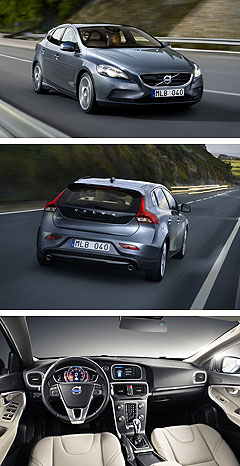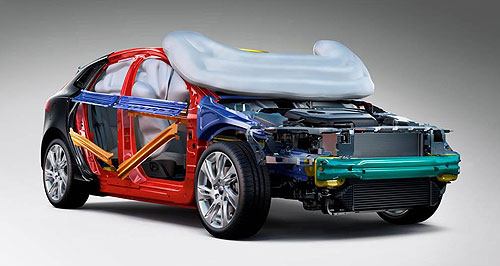Future models - Volvo - V40Pedestrian airbag to be standard on Volvo V40World first: The Volvo V40’s pedestrian airbag is designed to inflate within a few milliseconds. Volvo’s all-new V40 hatch to feature groundbreaking pedestrian airbag across range24 May 2012 By TERRY MARTIN VOLVO has confirmed its forthcoming V40 premium hatchback will be fitted standard with an industry-leading pedestrian airbag when it reaches the Australian market early next year. Volvo Car Australia public affairs manager Oliver Peagam has told GoAuto that the entire Australian V40 line-up will have the groundbreaking new technology as standard equipment, and that the Swedish manufacturer was working to broaden its application to other vehicles in the brand’s stable. “The intention with any new technologies we have debuted on a specific model is for that technology to appear on the rest of the models in our range as soon as possible,” said Mr Peagam, pointing to the ‘City Safety’ low-speed collision avoidance system, which is now widely available after its debut on XC60, as an example. Volvo Car Corporation this week released further details of the pedestrian airbag – claimed to be a world-first when the V40 was unveiled at the Geneva motor show three months ago – which forms part of the company’s strategy that aims for no-one to be killed or injured in one of its new vehicles by 2020. With Volvo claiming that most vehicle collisions with pedestrians occur at up to 40km/h, the system operates at speeds between 20km/h and 50km/h and is designed to prevent serious head injuries that stem from the hard areas under the bonnet, at the lower edge of the windscreen and the front pillars.  Volvo Car Corporation senior technical advisor (safety) Thomas Broberg said the front bumper had seven sensors uniquely configured to recognise human-like leg forms and trigger the airbag. Volvo Car Corporation senior technical advisor (safety) Thomas Broberg said the front bumper had seven sensors uniquely configured to recognise human-like leg forms and trigger the airbag.“People are soft and cars are hard, and in order to try to cushion the impact, the airbag has two purposes: firstly, to lift the bonnet to create additional space between the bonnet and the hard components in the engine bay, like the engine and secondly, to cushion the area around the windshield wipers and the lower part of the A-pillars,” he said. When the car comes into contact with an object, the front sensors are designed to transmit specific signals to a control unit, which in turn will deploy the airbag if it registers that the object is a human leg. The back end of the bonnet panel is automatically unhinged at the same moment the airbag begins inflation, enabling the airbag to raise the bonnet 10cm and remain in that position. Fully inflated, the airbag covers the entire windscreen wiper recess, about a third of the windscreen and the lower part of the A-pillars. Volvo says the entire sequence from system activation to full inflation takes a few hundredths of a second. “The system has gone through extensive testing and computer-aided engineering in order to verify its performance – performance both in different impact situations as well as in different road and weather conditions,” Mr Broberg said. The latest figures from the federal infrastructure and transport department show that pedestrian collisions account for about 15 per cent of all road deaths in Australia. For the 12 months to the end of April this year, 191 pedestrian deaths were recorded, up from 176 over the same period in 2011 and 182 in 2010. Europe has a similar percentage of pedestrian deaths, while China reportedly has a 25 per cent fatality rate. Volvo’s pedestrian airbag system comes two years after it launched its ‘pedestrian detection’ system with full automatic brake – technology that can avoid a collision with a pedestrian at speeds of up to 35km/h if the driver does not respond in time. At higher speeds, the aim is to reduce the car’s speed as much as possible before the collision.  Read moreV40 pricing
Motor industry news |
Click to shareVolvo modelsResearch Volvo V40 pricing
Motor industry news |
















Facebook Twitter Instagram